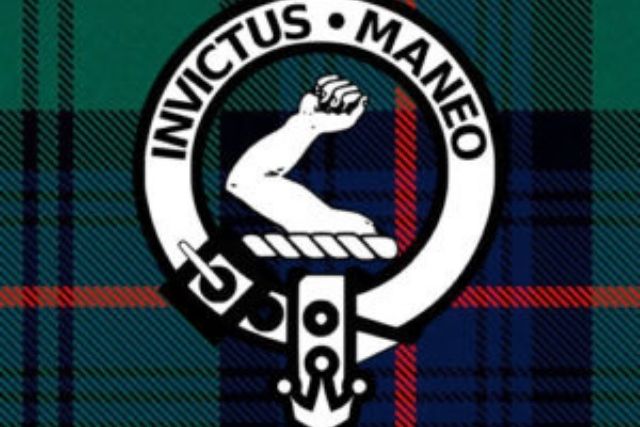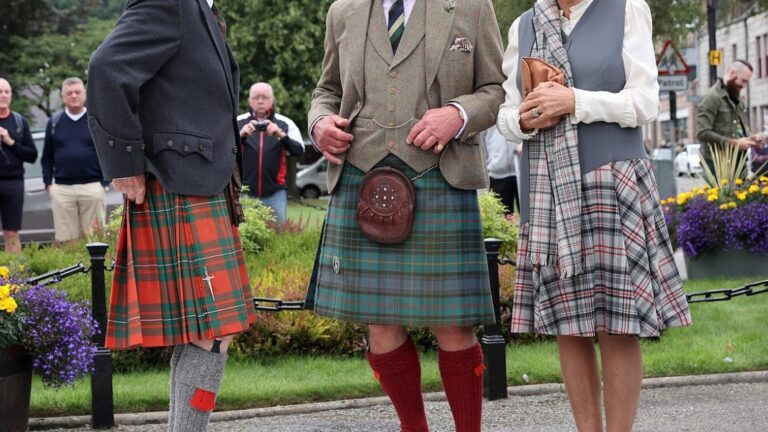In the realm of body art, Celtic tattoos have stood the test of time, captivating individuals with their intricate designs and rich symbolism. Combining ancient traditions with modern interpretations, these tattoos serve as powerful visual expressions of heritage, spirituality, and personal identity.
From the mesmerizing beauty of Celtic knotwork to the profound meanings embedded within each symbol, this article explores the fascinating world of Celtic tattoos, providing insights into their history, designs, and care.
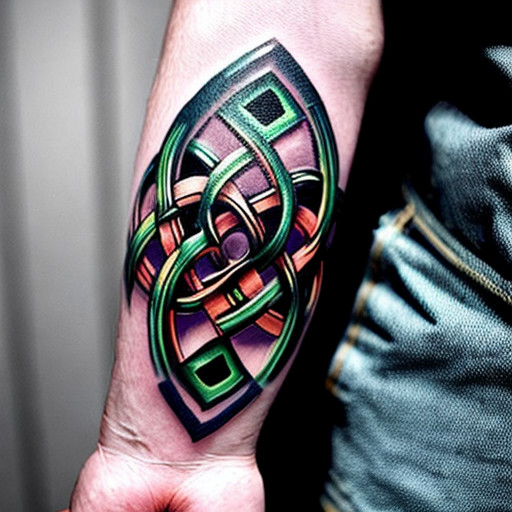
The History of Celtic Tattoos
Exploring the origins and evolution of Celtic tattoos, a rich and intricate tradition can be discovered. Celtic tattoos have a long and storied history, with roots that can be traced back to ancient times. The Celts, an ancient tribe from Europe, were known for their intricate artwork and symbolism.
Their tattoos were often inspired by nature, with designs featuring animals, plants, and intricate knotwork. Traditional Celtic tattoos were often done in black ink, using bold lines and intricate patterns. Some popular designs include the Celtic tribal tattoos, traditional Irish tattoos, the warrior Celtic cross tattoo, and ancient Celtic tattoos. These designs were not only decorative, but also held deep cultural and spiritual significance for the Celtic people.
Today, traditional Celtic tattoos continue to be popular, with many individuals embracing the rich history and symbolism associated with these designs.
Traditional Celtic Tattoo Designs
Traditional Celtic tattoo designs have been passed down through generations and continue to captivate individuals today. These designs are deeply rooted in Celtic history and culture, representing the rich heritage of the Celtic people. Celtic warrior tattoos, also known as Irish warrior tattoos, are among the most popular traditional designs. These tattoos often feature intricate patterns and symbols that signify bravery, strength, and honor.
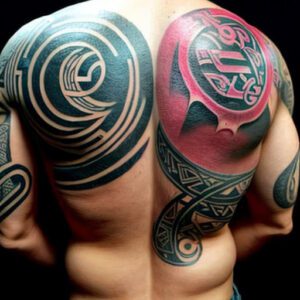
Gaelic tattoos, another traditional Celtic design, incorporate ancient Gaelic script and symbols, preserving the language and traditions of the Celtic people. Irish tribal tattoos, on the other hand, showcase bold and abstract patterns that symbolize the unity and interconnectedness of the Celtic community. Celtic symbolic tattoos are highly revered for their intricate knotwork and symbolic meanings, often representing concepts like eternity, love, and spirituality. These traditional designs serve as a link to the past, connecting individuals to their Celtic roots and cultural heritage.
Transition: While traditional Celtic tattoo designs hold great significance, modern interpretations of these tattoos have also gained popularity in recent times.
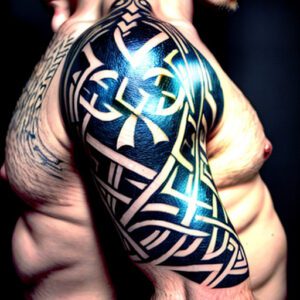
Modern Interpretations of Celtic Tattoos
With the evolving cultural landscape, contemporary artists have reimagined and revitalized Celtic tattoo designs, breathing new life into this ancient art form. Modern interpretations of Celtic tattoos have embraced the rich symbolism and intricate patterns of traditional designs while also incorporating new elements and styles.
One popular modern interpretation is the use of Celtic tattoos for protection. These tattoos often feature symbols such as the Triquetra or the Celtic shield knot, believed to ward off negative energies and bring good fortune.
Another modern interpretation is the Irish tree tattoo, which represents the connection between nature and spirituality. Inspired by historical Pictish tattoos, modern Celtic tattoos also incorporate elements from ancient Celtic mythology and folklore.

These modern interpretations of Celtic tattoos continue to evolve and adapt, reflecting the ever-changing cultural landscape. Transitioning into the subsequent section about Celtic knotwork tattoos, let’s delve into the mesmerizing patterns and meanings behind these intricate designs.
Celtic Knotwork Tattoos
Amidst the rich tapestry of Celtic tattoo designs, Celtic knotwork tattoos stand out as captivating creations that showcase the intricate interweaving patterns synonymous with this ancient art form.
These tattoos are not only aesthetically pleasing, but they also hold deep cultural and symbolic significance. Celtic knotwork tattoos are often associated with protection and are believed to ward off evil spirits. These designs can incorporate traditional Irish symbols such as the Celtic trinity knot or the rowan tree tattoo, which is believed to bring luck and protection.
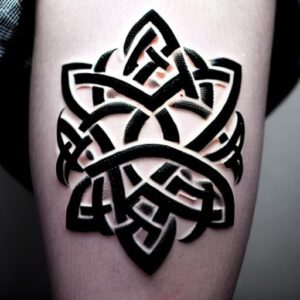
Celtic knotwork tattoos are not limited to a specific gender and can be worn by both men and women. They are popular among females due to their elegant and feminine designs. Whether it’s a small and delicate knotwork tattoo on the wrist or an elaborate tribal-inspired design on the back, Celtic knotwork tattoos are timeless pieces of art that pay homage to the rich Celtic heritage.
Symbolic Meanings of Celtic Tattoos
Exploring the profound symbolism of Celtic tattoos reveals a depth of meaning that resonates with individuals seeking to connect with their cultural heritage. Celtic tattoos are rich in symbolism and carry messages of spirituality, protection, and eternal love.
Here are three symbolic meanings commonly associated with Celtic tattoos:
- Spiritual Connection: Celtic knots, with their intricate patterns and endless loops, symbolize the eternal cycle of life, death, and rebirth. They represent the interconnectedness of all things and serve as a reminder of our spiritual journey.
- Protection and Strength: The Celtic cross is a popular tattoo design that combines Christian and Celtic symbolism. It represents the meeting point between the physical and spiritual realms and is believed to offer protection and strength to the wearer.
- Love and Unity: The Claddagh symbol, a heart held by two hands with a crown on top, is a powerful symbol of love, loyalty, and friendship. It is often used in Celtic tattoos to represent the bond between loved ones and the importance of unity within a community.
Celtic tattoos hold a deep significance for those who choose to adorn their bodies with these ancient symbols, allowing them to honor their heritage and carry the profound meaning of their culture with them wherever they go.
The Triskele in Celtic Tattoo Art
One popular symbol found in Celtic tattoo art is the Triskele. It holds significant meaning and is often chosen by individuals looking to embrace their Celtic heritage. The Triskele is a complex symbol that consists of three interconnected spirals, creating a design that is visually captivating.
It is believed to represent various concepts such as the cycle of life, death, and rebirth, as well as the eternal flow of energy. Each spiral in the Triskele is said to symbolize different aspects of existence, including the past, present, and future or the physical, mental, and spiritual realms.
The Triskele can also be associated with the three Celtic elements – earth, water, and air. Overall, the Triskele in Celtic tattoo art is a powerful symbol that encapsulates the rich history and spiritual beliefs of the Celtic culture.
Exploring Celtic Cross Tattoos
Celtic Cross tattoos have gained popularity among individuals who seek to embrace their Celtic heritage and showcase a symbol that holds deep religious and cultural significance. The Celtic Cross, also known as the Irish Cross or the High Cross, is a cross with a ring surrounding the intersection. This unique design combines the Christian cross with traditional Celtic knotwork, resulting in a powerful symbol that represents unity, faith, and eternity.
Symbol of faith:
The Celtic Cross is often associated with Christianity and represents the Christian faith. It is believed to have been introduced by St. Patrick, who combined the symbol of the cross with the traditional Celtic circle to incorporate both religions.
Connection to Celtic culture:
Celtic Cross tattoos are a way for individuals to connect with their Celtic heritage and express their pride in their roots. These tattoos often feature intricate knotwork patterns that symbolize the interconnectedness of life.
Protection and spirituality:
The Celtic Cross is believed to offer protection against evil spirits and bring good luck. Many people choose to get these tattoos as a way to invoke spiritual guidance and safeguard themselves on their life’s journey.
Animals and Nature in Celtic Tattoo Designs
As animals and nature hold great significance in Celtic culture, they are often incorporated into Celtic tattoo designs to symbolize various qualities and beliefs. Celtic mythology is rich with stories of animals and their connection to the natural world, and these themes are reflected in the intricate designs of Celtic tattoos.
One common animal motif in Celtic tattoo art is the Celtic knotwork, which often features animals intertwined with intricate patterns. The animals depicted can vary, but some popular choices include the stag, which symbolizes strength and nobility, the wolf, which represents loyalty and guardianship, and the raven, which is associated with wisdom and prophecy.
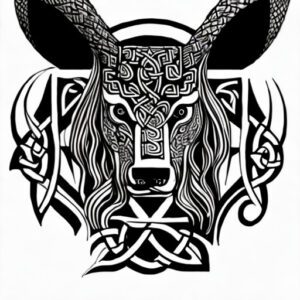
Other elements of nature, such as trees, flowers, and rivers, are also commonly seen in Celtic tattoo designs, representing the interconnectedness of all living beings and the cyclical nature of life.
Celtic Warrior Tattoos
Warriors and their bravery played a significant role in Celtic society, and Celtic warrior tattoos reflect this valor and honor. These tattoos are not only a symbol of strength and courage but also serve as a reminder of the warrior’s commitment to their tribe and their readiness to defend it at all costs.
Here are three key elements often found in Celtic warrior tattoos:
- Weapons: Swords, spears, and shields are commonly depicted in Celtic warrior tattoos. These weapons represent the warrior’s martial skills and their ability to protect their people.
- Knotwork: Intricate Celtic knotwork is often incorporated into warrior tattoos. These knots symbolize the interconnectedness of life and the warrior’s unity with their tribe.
- Animal motifs: Many Celtic warrior tattoos feature animal motifs such as wolves, bears, and eagles. These animals symbolize bravery, ferocity, and the warrior’s connection to the natural world.
Celtic warrior tattoos serve as powerful reminders of the bravery and resilience exhibited by the ancient Celtic warriors.
Female Celtic Tattoo Designs
Featuring intricate knotwork and delicate floral patterns, female Celtic tattoo designs showcase the elegance and beauty associated with Celtic culture. These designs often incorporate symbols such as the Celtic Trinity Knot, which represents the interconnectedness of mind, body, and spirit. Another popular design is the Celtic Tree of Life, symbolizing growth, strength, and the continuous cycle of life. Celtic spirals and interlacing patterns are also commonly used in female Celtic tattoos, representing infinite love and connection.
The use of vibrant colors, such as emerald green and deep purple, adds a feminine touch to these designs. Additionally, Celtic animal motifs like the swan, symbolizing grace and beauty, and the butterfly, representing transformation and rebirth, are popular choices for women.
Female Celtic tattoo designs can be placed on various parts of the body, depending on personal preference and the size of the design. Now, let’s explore some Celtic tattoo placement ideas to help you find the perfect spot for your Celtic tattoo.
Celtic Tattoo Placement Ideas
When considering Celtic tattoo placement ideas, it is important to take into account both the size of the design and the individual’s personal preferences. Here are three popular placement options for Celtic tattoos:
- Arm: The upper arm is a common choice for Celtic tattoos, allowing for a larger and more intricate design. This placement is easily visible and can be easily covered if desired.
- Back: The back provides a larger canvas for Celtic tattoos, allowing for more elaborate designs such as Celtic knots or Celtic animals. This placement offers the option of showcasing the tattoo or keeping it hidden, depending on the individual’s preference.
- Wrist: For those looking for a smaller and more discreet Celtic tattoo, the wrist is an ideal placement. This area allows for simpler designs like Celtic symbols or small knots. It is important to note that the wrist is a visible area and may not be suitable for those who wish to keep their tattoo private.
Considering the placement of your Celtic tattoo is crucial in order to achieve the desired aesthetic and meaning. Once you have decided on the placement, the next step is to choose the right Celtic tattoo artist.
Choosing the Right Celtic Tattoo Artist
Finding a skilled and experienced Celtic tattoo artist can make all the difference in ensuring the quality and authenticity of your tattoo. When choosing a Celtic tattoo artist, it is important to consider their level of expertise in Celtic designs and their experience in tattooing.
Look for artists who specialize in Celtic tattoos and have a portfolio showcasing their previous work in this style. Pay attention to the details and intricacy of their designs, as well as the precision and cleanliness of their tattooing techniques.
It is also beneficial to read reviews or seek recommendations from others who have had Celtic tattoos done. Meeting with the artist beforehand to discuss your ideas and expectations can also help in determining if they are the right fit for you.
The Significance of Celtic Tattoo Colors
Both the variety and symbolism of Celtic tattoo colors play a significant role in the overall meaning and visual impact of these intricate designs. Celtic tattoos are known for their vibrant and bold colors, which add depth and character to the artwork.
Here are three key aspects of Celtic tattoo colors:
- Green: Green is a prominent color in Celtic culture and symbolizes life, growth, and fertility. It is often used to represent the natural world and the connection between humans and nature.
- Blue: Blue is associated with the sea and the sky, representing wisdom, tranquility, and spirituality. It is often used to symbolize inner peace and the quest for knowledge.
- Red: Red is a powerful color in Celtic symbolism, representing passion, courage, and strength. It is often used to convey bravery and determination in the face of challenges.
The choice of colors in a Celtic tattoo can enhance the overall meaning and impact of the design, making it a personal and meaningful piece of art.
Celtic Tattoo Inspiration From Ancient Art
Exploring the intricate patterns and rich symbolism found in ancient Celtic art can provide a wealth of inspiration for creating unique and meaningful Celtic tattoos. The art of the ancient Celts was characterized by its intricate knotwork, spirals, and interwoven patterns, which were often used to depict animals, nature, and mythological figures. These elements can be incorporated into tattoo designs to create visually stunning and symbolic pieces.
The knotwork, for example, symbolizes the interconnectedness of life, while spirals represent the eternal cycle of life, death, and rebirth. Animals such as wolves, stags, and birds were also commonly depicted in Celtic art, each carrying its own symbolic meaning.
Incorporating Personal Elements Into Celtic Tattoos
Using personal symbols and meaningful imagery, individuals can enhance the beauty and significance of their Celtic tattoos. By incorporating elements that hold personal significance, these tattoos become more than just a design, but a reflection of one’s unique identity and story.
Here are three ways to incorporate personal elements into Celtic tattoos:
- Birthstones: Adding the birthstone of oneself or a loved one into a Celtic tattoo can symbolize important dates or relationships. It adds a personal touch and creates a deeper connection to the design.
- Family Crests: Including elements from one’s family crest or coat of arms can honor and pay tribute to ancestral heritage. It serves as a reminder of one’s roots and provides a sense of pride.
- Meaningful Quotes or Words: Adding meaningful quotes or words in Celtic script can bring a personal message or mantra to the tattoo. It allows the individual to express their values, beliefs, or aspirations through their body art.
By incorporating these personal elements, Celtic tattoos become more than just a design, but a representation of one’s unique story and identity.
Now, let’s explore the topic of Celtic tattoo sleeve designs.
Celtic Tattoo Sleeve Designs
When considering Celtic tattoo sleeve designs, individuals have a wide array of options to choose from in order to create a visually striking and culturally significant piece of body art. Celtic tattoo sleeves typically cover the entire arm, from shoulder to wrist, and are characterized by intricate knotwork patterns, interlacing designs, and Celtic symbols.
These designs can be customized to incorporate personal elements such as family crests, birth dates, or meaningful quotes. Some popular Celtic tattoo sleeve designs include the Celtic cross, the tree of life, the triquetra, and the spiral. Each design carries its own symbolism and can be further enhanced with the use of vibrant colors or shading techniques.
Celtic tattoo sleeve designs are highly versatile and offer individuals the opportunity to showcase their heritage and personal style in a visually stunning manner.
Celtic Tattoos for Men
In the realm of body art, Celtic tattoos for men provide a unique and striking way for individuals to showcase their masculinity and express their deep connection to Celtic heritage. These tattoos are not only visually appealing but also carry significant symbolism.
Here are three popular Celtic tattoo designs for men:
- Celtic Cross: The Celtic cross is a powerful symbol that represents faith, spirituality, and the connection between the physical and spiritual worlds. It is often adorned with intricate knotwork and can be personalized with additional elements such as animals or tribal patterns.
- Celtic Knots: Celtic knots are intricate and endless designs that symbolize eternity and interconnectedness. They can be incorporated into various tattoo designs, such as animal forms or as standalone knots. These tattoos represent the unbreakable bonds of family, love, and friendship.
- Celtic Warrior: Celtic warriors were revered for their bravery, strength, and honor. Choosing a Celtic warrior tattoo represents these qualities and showcases a man’s resilience and courage. These tattoos often feature warriors in battle attire or Celtic war symbols.
Celtic tattoos for men not only make a bold statement but also serve as a powerful reminder of their Celtic roots and the values they hold dear.
Celtic Tattoos for Women
Embracing their individuality and celebrating their connection to Celtic culture, women are increasingly opting for Celtic tattoos as a way to showcase their strength and beauty. Celtic tattoos for women often incorporate intricate knotwork, symbolizing the interconnectedness of life and the eternal cycle of nature.
These designs can be placed on various parts of the body, depending on personal preference and visibility. Popular choices for women include Celtic knots, which represent unity and eternal love, as well as the triskelion, a symbol of personal growth and transformation.
Other common motifs include the Celtic tree of life, which symbolizes balance and harmony, and the Claddagh symbol, representing love, loyalty, and friendship.
Celebrities With Celtic Tattoos
Several notable celebrities have chosen to adorn their bodies with Celtic tattoos, showcasing their appreciation for the rich cultural heritage and timeless beauty of Celtic art. These tattoos not only serve as a form of personal expression but also as a way to pay homage to their Celtic roots.
Here are three celebrities who proudly display their Celtic tattoos:
- Colin Farrell: The Irish actor has a Celtic cross tattoo on his left forearm, symbolizing his deep connection to his Irish heritage.
- Johnny Depp: Known for his love for tattoos, Depp has a Celtic tree of life inked on his right arm. This intricate design represents the interconnectedness of all living things.
- Angelina Jolie: Jolie has a Celtic symbol tattooed on her lower back. The design is a combination of a Celtic knot and a dragon, representing strength, power, and eternal love.
These celebrities’ Celtic tattoos serve as both personal statements and reminders of the beauty and significance of Celtic art and culture.
Celtic Tattoo Care and Aftercare Tips
Proper care and maintenance are essential for ensuring the longevity and vibrancy of your Celtic tattoo. After getting inked, it is crucial to follow a strict aftercare routine to promote healing and prevent infection.
Firstly, keep the tattoo covered with a sterile bandage for a few hours to protect it from bacteria. Once the bandage is removed, gently wash the tattoo with lukewarm water and fragrance-free soap, using your clean hands. Avoid scrubbing or using abrasive materials, as this can damage the tattoo and hinder the healing process.
After washing, pat the tattoo dry with a clean towel and apply a thin layer of fragrance-free, alcohol-free moisturizer.
It’s important to avoid excessive exposure to sunlight, swimming, and excessive sweating during the healing process. Additionally, refrain from picking at any scabs, as this can cause scarring.


